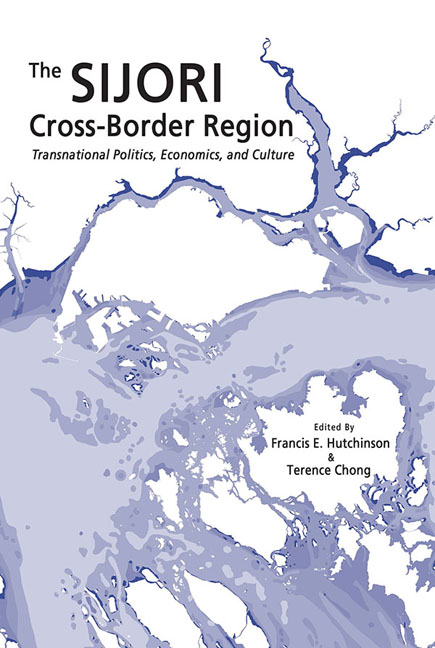Book contents
- Frontmatter
- Contents
- List of Maps
- List of Tables
- List of Figures
- Foreword
- Acknowledgements
- Contributors
- Abbreviations
- Introduction
- Section I Understanding the Whole
- Section II Policy and Politics
- Map3
- 4 The Social Construction of Comparative Advantage and the SIJORI Growth Triangle
- 5 The Political Economy of Closer Relations: A Perspective from Singapore
- 6 A Periphery Serving Three Cores: Balancing Local, National, and Cross-Border Interests in the Riau Islands
- 7 Political Contestation in Iskandar Malaysia: Views on Economic Integration during Malaysia's 13th General Election
- 8 Johor Survey: Interethnic Dissonance
- Section III Cross-Border Social and Cultural Communities
- Section IV Formal and Informal Economies
- Conclusion
- Appendix
- Sources for the SIJORI Maps
- Index
6 - A Periphery Serving Three Cores: Balancing Local, National, and Cross-Border Interests in the Riau Islands
from Section II - Policy and Politics
Published online by Cambridge University Press: 22 July 2017
- Frontmatter
- Contents
- List of Maps
- List of Tables
- List of Figures
- Foreword
- Acknowledgements
- Contributors
- Abbreviations
- Introduction
- Section I Understanding the Whole
- Section II Policy and Politics
- Map3
- 4 The Social Construction of Comparative Advantage and the SIJORI Growth Triangle
- 5 The Political Economy of Closer Relations: A Perspective from Singapore
- 6 A Periphery Serving Three Cores: Balancing Local, National, and Cross-Border Interests in the Riau Islands
- 7 Political Contestation in Iskandar Malaysia: Views on Economic Integration during Malaysia's 13th General Election
- 8 Johor Survey: Interethnic Dissonance
- Section III Cross-Border Social and Cultural Communities
- Section IV Formal and Informal Economies
- Conclusion
- Appendix
- Sources for the SIJORI Maps
- Index
Summary
INTRODUCTION
This chapter describes the political and institutional setting of the Riau Islands (Kepulauan Riau), Indonesia's province that forms part of the Singapore-Johor-Riau (SIJORI) Cross-Border Region. More focus will be given to three parts of the Riau Islands Province (henceforth PRI) which are closest to Singapore: Batam, Bintan, and Karimun (henceforth BBK). Special attention will be directed towards Batam, the industrial hub and population centre of the province.
Batam holds a unique position in Indonesia's political-economic history because of its special privileges as an area exempt from some taxes and duties. Batam's economic development model — as well as the fact that it is only 20 kilometres away from Singapore — has attracted large amounts of foreign and domestic investments, provided jobs and other opportunities for many Indonesians, and turned the island from a sleepy village of 6,000 people in 1971 (Tim Peneliti Hubungan Internasional 2001) to a bustling city of 1,065,000 people in 2012 (BPS Kepulauan Riau 2013).
Batam's development model has been expanded to the neighbouring islands of Bintan and Karimun, and has inspired Indonesia to revise its laws governing foreign investment and free trade zones in 2007 and adopt a new law governing special economic zones in 2009. Batam has also endured various political changes which have taken place in Indonesia: from the top-down era of President Soeharto to the local autonomy era since 2000. Many of these political changes were beyond Batam's or even PRI's sphere of influence but nevertheless had to be endured.
This chapter is made up of six sections. The first section provides a quick overview of PRI's geography, demography, and economy, leading to a justification as to why attention will be given to BBK. The second section provides a brief overview of the Indonesian political system as a background of PRI's institutional setting. In the third section, BBK but especially Batam is explored in more detail as a case study in the political history of free trade zones in Indonesia. This is intended to provide readers with an understanding of Batam's developmental trajectory from an institutional point of view, the debates that it has triggered, and the regulatory changes that followed suit. The fourth section explains the rapid growth that took place in Batam from the 1990s onwards and its social and environmental consequences.
- Type
- Chapter
- Information
- The SIJORI Cross-Border RegionTransnational Politics, Economics, and Culture, pp. 154 - 180Publisher: ISEAS–Yusof Ishak InstitutePrint publication year: 2016

